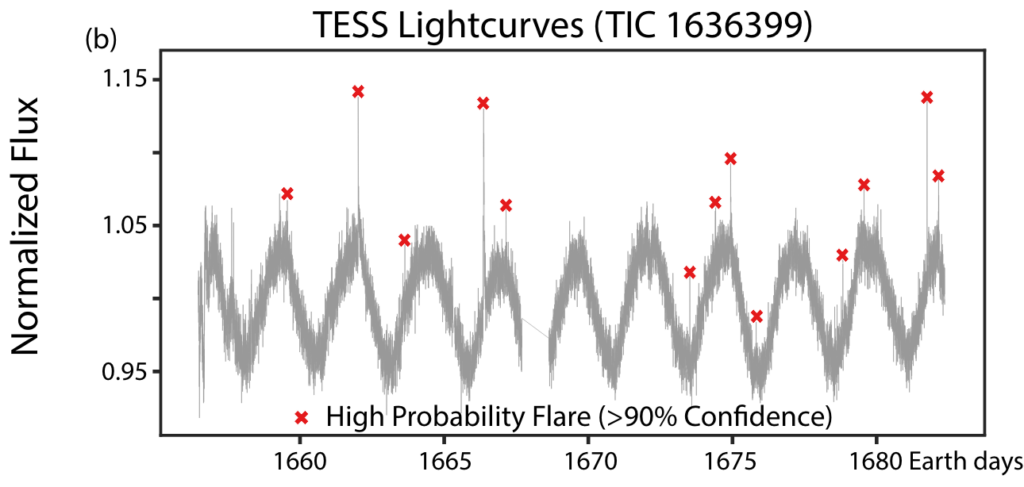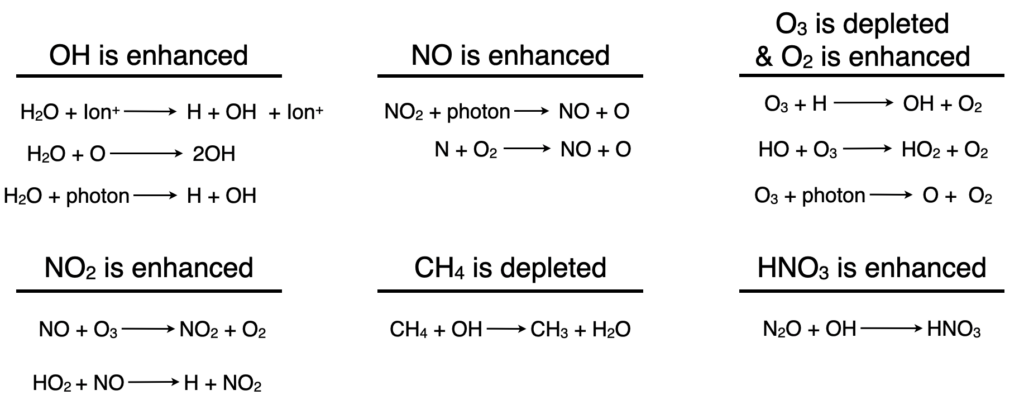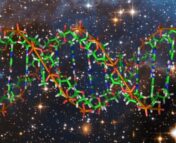Title: Persistence of Flare Driven Atmospheric Chemistry on Rocky Habitable Zone Worlds
Authors: Howard Chen, Zhuchang Zhan, Allison Youngblood, Eric T. Wolf, Adina D. Feinstein, and Daniel E. Horton
First Author’s Institution: Center for Interdisciplinary Exploration & Research in Astrophysics (CIERA), Evanston, IL, 60202, USA
Status: Published in Nature Astronomy [Closed Access]. Available on ArXiv [Open Access]
Biological Tracers in Atmospheres

We all want to know the answer to the question, “Is there life beyond Earth in the Universe?” Unfortunately, this question is significantly harder to answer than it is to ask. One way we can begin to answer, “is there life?” is by looking at planets beyond our Solar System, known as exoplanets. With the upcoming launch of the James Webb Space Telescope (October 2021), we’ll soon be able to observe the atmospheres of exoplanets to search for possible bio-signatures.
Atmospheric bio-signatures are molecules that are believed to be indicators of life or molecules that are essential for life to exist. For example, H2O, O2, and O3 are useful in determining whether a planet could host life, while species such as HNO3, N2O, and CH4 are indicators of existing life (Figure 1). However, bio-signatures can be produced abiotically (without life) from events such volcanic eruptions or variable stellar activity, so we have to be careful if we say a specific molecule indicates life.
Stars are variable in time, where they can undergo eruptions or “flares” of high energy (UV, X-ray) photons (Figure 2). These flares can increase ionization rates in planetary atmospheres, and thus impact atmospheric chemistry. Today’s paper uses models to determine how flaring events from stars impact the chemistry in the atmosphere of a three different planets.

Modeling Exoplanets and Flares
Today’s paper models three different planets defined as G-, K-, and M-star planets using the Whole Atmosphere Community Climate Model (WACCM). Each planet assumes a rocky surface and nitrogen rich atmosphere (like Earth) and orbits a dwarf star. Each planet varies by its magnetic field, rotation rate, and stellar parameters.
- G-star (Earth like) planet: This planet has a strong magnetic field and rotates rapidly about a G-star similar to the Sun;
- K-star (HD85512) planet: this planet has a week magnetic field and rotates quickly about a K-star similar to HD85512;
- M-star (TRAPPIST-1) planet: this planet has a weak magnetic field and a slow rotation about an M-star similar to TRAPPIST-1.
A stellar flare is induced in the WACCM model to monitor how the atmospheric chemistry is impacted over time. They use both a “super-strong” flare (E>1e33 ergs, photon flux > 1e14 cm-2) modeled by MUSCLES and observed flares in dwarf stars. (note from the author: please go to the MUSCLES webpage and look at their logo. This needs to be shared.)

Biological Tracers: Just Add Flare
Not only do the authors find that strong stellar flares can drive the chemical composition of atmospheres to change, but a flare can permanently change the chemical composition to a new steady state. A stellar flare causes an enhancement in NO, OH, NO2, HNO3, and H2O abundances and a depletion in O3 and CH4 abundances. Changes in NO, OH and O3 abundances are the most prominent and can be seen in Figure 3. These species were impacted the least in the G-star planet, likely due to its magnetic field, but the M- and K-star planets seem to suffer from a permanent loss of O3. Figure 4 shows a few of the chemical and physical reactions, driven by the flare, that cause the abundances to change.

Today’s paper showed us that stellar flares can abiotically produce possible biological tracers, such as HNO3 and NO2, while also reducing some biological tracers such as CH4. Unfortunately, this means that detecting signs of life in exoplanets is a bit harder than it was before. Flares, which are a common occurrence in stars, can change the chemistry of an atmosphere over time. This variability will make it even more difficult to determine if biological tracers were produced biotically or abiotically.
Special thanks to Alison Crisp for editing this bite!
Credit for Featured Image: TRAPPIST-1e from NASA/JPL-Caltech with some added clip art by Abby Waggoner




